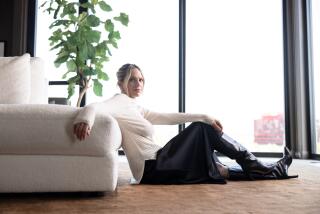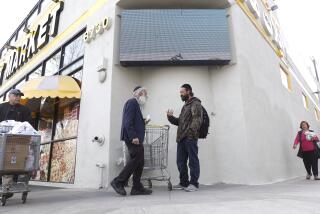MONUMENT TO IDENTITY
In the melting pot that is America, some immigrant cultures assimilate better than others.
Ethnicities as distinct and varied as Swedes and Italians, Mexicans and Armenians have all, to varying degrees, blended their original identities into the American national stew while other groups struggle to keep the core of their native cultures distinct from the mainstream.
In the 20th century, Jewish culture has become one of the most vivid ingredients in the national melting pot and one of the most deeply integrated. In fact, American Jews have become so embedded in the cultural mainstream that many wonder which part of their identity is distinctly Jewish rather than simply American in a society in which Jewish humor is widely appreciated and Yiddish expressions are commonplace.
The new $65-million Skirball Cultural Center in Sherman Oaks sets out to explore that question. Situated near Mulholland Drive at the crest of the Sepulveda Pass between the Westside and the Valley--the two major areas of Jewish population in Los Angeles--the center is simultaneously a museum of Jewish history and a venue where members of the 600,000-strong local community may meet and discuss their cultural identity as Jews and as Americans. The new center replaces the original Skirball Museum of Judaica, which shared a campus with Hebrew Union College close to USC.
“We asked ourselves the question: How do secular American Jews define their identity, other than by their possible attachment to the state of Israel or their collective memory of the Holocaust?” said Uri Herscher, the Skirball Center’s president.
“The center provides no ready answers to this complex query, but it does provide a gathering place where modern American Jewish identity can be argued and examined in the context of our long history,” he said.
Designed by Boston-based architect Moshe Safdie, the Skirball Center is a serenely handsome Modernist complex nestled into the chaparral-covered hillside two miles north of the new Getty Center nearing completion in Brentwood.
Bands of pink Quebec granite alternate with panels of polished stainless steel and large areas of glass, topped by metallic roofs with curved peaks. In the Modernist manner, the details are simple, not fussy. The building’s profiles are crisp, with a touch of the kind of jauntiness that marks much of Safdie’s architecture.
*
Organized in three wings around two large outdoor courts, the four-story center includes the nationally known Skirball Museum of Jewish History, a 350-seat auditorium, a conference room, an educational complex with classrooms and a discovery center for children that features a biblical archeological dig. The outdoor courtyards, facing the hillside slopes, are used for concerts, performances and special events.
“The extraordinary thing about this site is that, although it’s plumb center in the middle of L.A., it sits in wild countryside,” Safdie said. “So I have tried to design a place that is urbane yet responds to its natural setting. To me, that balance between buildings and nature is the essence of Angeleno Modernism, all the way back to Richard Neutra and Rudolph Schindler.”
Safdie’s background seems made to fit for the questions of cultural identity posed by the center. Born and raised in Israel, Safdie worked in Canada in the 1960s and designed the innovative Habitat apartment complex for the 1967 Montreal Expo before establishing offices in Jerusalem and in Boston, where he now lives.
He has designed several major public projects in Canada, including the National Gallery in Ottawa, the Montreal Museum of Fine Arts and the new Vancouver library.
The Skirball is Safdie’s first public project in the United States. It also marks a return to his early Modernist manner after the Post-Modernist style that has characterized his work in the last two decades. In the Skirball, Safdie has been influenced by the Modernist simplicity of the late Louis Kahn, who designed the Salk Institute in La Jolla.
The heart of the Skirball is the museum. Here a display of 400 years of the history of Jewish life in America follows a series of exhibits outlining 4,000 years of Hebrew history stretching back to the pharaohs. The ruins of a third century synagogue from Tiberias on the shores of Lake Galilee are within sight of the gilded dome of the Ark of the Covenant from the splendid 19th century Berlin New Synagogue, which was destroyed in an air raid in 1943.
A half-size mock-up of the hand holding the torch of the Statue of Liberty is around the corner from a dark, quiet chamber with a single candle commemorating the Holocaust.
The museum, like all the wings of the complex, has a slanted ceiling culminating in a continuous, vaulted skylight. These curved vaults provide a diffused illumination that softens the harsh Southern California sunlight, and they create the lively peaked profiles you see as you approach the complex from the north or south.
Finishes throughout the center emphasize coolness, from the gray slate floors to the white-painted walls and ceilings and smooth bare concrete surfaces. Exterior pergolas and covered walkways reach out to embrace the wild slopes, linking the building and landscape.
Founded in Cincinnati in 1875, Hebrew Union College, including the museum of Judaica that evolved into the Skirball Center, moved to Los Angeles in 1965. In its new location, the center maintains links with its other campus in Jerusalem, also designed by Safdie, and with satellite facilities in Cincinnati and New York City.
“At this stage of its profound integration into American society, the Jewish community seems uncertain of what, exactly, it means to be a Jew in the United States in this day and age,” Herscher said. “The Skirball Center is one place where you can come and try to negotiate that fascinatingly complex identity.”
More to Read
The biggest entertainment stories
Get our big stories about Hollywood, film, television, music, arts, culture and more right in your inbox as soon as they publish.
You may occasionally receive promotional content from the Los Angeles Times.










